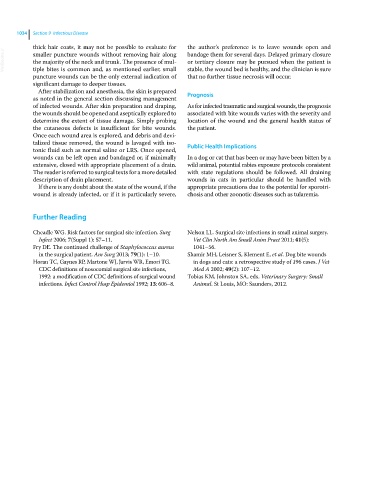Page 1096 - Clinical Small Animal Internal Medicine
P. 1096
1034 Section 9 Infectious Disease
thick hair coats, it may not be possible to evaluate for the author’s preference is to leave wounds open and
VetBooks.ir smaller puncture wounds without removing hair along bandage them for several days. Delayed primary closure
or tertiary closure may be pursued when the patient is
the majority of the neck and trunk. The presence of mul-
tiple bites is common and, as mentioned earlier, small
that no further tissue necrosis will occur.
puncture wounds can be the only external indication of stable, the wound bed is healthy, and the clinician is sure
significant damage to deeper tissues.
After stabilization and anesthesia, the skin is prepared
as noted in the general section discussing management Prognosis
of infected wounds. After skin preparation and draping, As for infected traumatic and surgical wounds, the prognosis
the wounds should be opened and aseptically explored to associated with bite wounds varies with the severity and
determine the extent of tissue damage. Simply probing location of the wound and the general health status of
the cutaneous defects is insufficient for bite wounds. the patient.
Once each wound area is explored, and debris and devi-
talized tissue removed, the wound is lavaged with iso- Public Health Implications
tonic fluid such as normal saline or LRS. Once opened,
wounds can be left open and bandaged or, if minimally In a dog or cat that has been or may have been bitten by a
extensive, closed with appropriate placement of a drain. wild animal, potential rabies exposure protocols consistent
The reader is referred to surgical texts for a more detailed with state regulations should be followed. All draining
description of drain placement. wounds in cats in particular should be handled with
If there is any doubt about the state of the wound, if the appropriate precautions due to the potential for sporotri-
wound is already infected, or if it is particularly severe, chosis and other zoonotic diseases such as tularemia.
Further Reading
Cheadle WG. Risk factors for surgical site infection. Surg Nelson LL. Surgical site infections in small animal surgery.
Infect 2006; 7(Suppl 1): S7–11. Vet Clin North Am Small Anim Pract 2011; 41(5):
Fry DE. The continued challenge of Staphylococcus aureus 1041–56.
in the surgical patient. Am Surg 2013; 79(1): 1–10. Shamir MH, Leisner S, Klement E, et al. Dog bite wounds
Horan TC, Gaynes RP, Martone WJ, Jarvis WR, Emori TG. in dogs and cats: a retrospective study of 196 cases. J Vet
CDC definitions of nosocomial surgical site infections, Med A 2002; 49(2): 107–12.
1992: a modification of CDC definitions of surgical wound Tobias KM, Johnston SA, eds. Veterinary Surgery: Small
infections. Infect Control Hosp Epidemiol 1992; 13: 606–8. Animal. St Louis, MO: Saunders, 2012.

